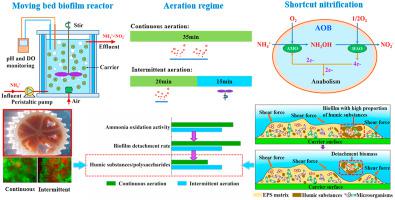Chemosphere ( IF 8.1 ) Pub Date : 2020-11-29 , DOI: 10.1016/j.chemosphere.2020.129141 Junjie Wang , Zhuwu Jiang , Weigang Wang , Han Wang , Yao Zhang , Yayi Wang

|
The effects of aeration regimes (intermittent and continuous aeration) on nitritation performance and biofilm EPS composition were evaluated in moving bed biofilm reactors (MBBRs), and a hypothesis that the aeration regimes affect EPS composition by affecting the microbial activity and sludge discharge content was proposed. The effluent NO2−/NH4+ ratio corresponded to that of an anammox reaction (1.07 ± 0.20) for the MBBR with continuous aeration (MBBRcon.), while that in the MBBR with intermittent aeration (20 min on/15 min off) (MBBRint.) was relatively lower (0.75 ± 0.19). Furthermore, the activity of ammonia-oxidizing bacteria in MBBRcon. was 0.4–7.9 mg-N·L−1·h−1 more than that in MBBRint., which was consistent with the lower proportion of dead cells in MBBRcon. compared with MBBRint. (9.4% vs. 31.8%). The higher microbial activity in MBBRcon. led to more sludge discharge than MBBRint., which was reflected in the higher biofilm detachment rate in MBBRcon. compared with MBBRint. (0.15 ± 0.02 vs. 0.11 ± 0.02 g m−2·d−1). The ratio of humic substances to polysaccharides in the EPS was high (0.96 ± 0.08) in the detachment biomass, while the ratios in the nitritation biofilm on carriers from MBBRcon. and MBBRint. were 0.52 ± 0.13 and 0.72 ± 0.16, respectively. We hypothesized that biofilm matrix with high ratios of humic substances to polysaccharides are structurally unstable and prone to fall off. In addition, the higher proportion of dead cells in MBBRint. made the proportion of humic substances in EPS high. Meanwhile, less sludge discharge in MBBRint. than MBBRcon. caused more humic substances to accumulate in the biofilm. These was responsible for the higher ratio of humic substances to polysaccharides in MBBRint. compared with MBBRcon. The findings elucidate the connection between aeration regimes and biofilm EPS composition, and guide the choice of aeration regimes in the design of biofilm reactors for partial nitritation.
中文翻译:

硝化生物膜中曝气方式与EPS组成之间的联系
在移动床生物膜反应器(MBBR)中评估了曝气方式(间歇和连续曝气)对硝化性能和生物膜EPS组成的影响,并提出了一种假设,即曝气方式通过影响微生物活性和污泥排放量来影响EPS组成。 。的流出物NO 2 - / NH 4 +之比对应于该一个厌氧氨氧化反应(1.07±0.20),用于与连续曝气的MBBR(MBBR的CON。 ),而在与间歇曝气的MBBR(20分钟开/ 15分钟关闭)(MBBR int。)相对较低(0.75±0.19)。此外,MBBR中氨氧化细菌的活性也有所提高。为0.4–7.9 mg-N·L -1·h -1比MBBR int高。,这与MBBR con中较低的死细胞比例一致。与MBBR int相比。(9.4%比31.8%)。MBBR con中较高的微生物活性。导致污泥排放量超过MBBR int。,这反映在MBBR con较高的生物膜分离率。与MBBR int相比。(0.15±0.02vs.0.11±0.02g m -2 ·d -1)。在分离生物质中,EPS中腐殖质与多糖的比率较高(0.96±0.08),而MBBR载体上的硝化生物膜比率较高。和MBBR诠释 分别为0.52±0.13和0.72±0.16。我们假设腐殖质与多糖比例高的生物膜基质在结构上不稳定,容易脱落。此外,MBBR int中死细胞的比例更高。使腐殖质在EPS中的比例很高。同时,MBBR int的污泥排放量更少。比MBBR con。导致更多的腐殖质积聚在生物膜中。这些是造成MBBR int中腐殖质与多糖比例更高的原因。与MBBR con相比。这些发现阐明了曝气方式与生物膜EPS组成之间的联系,并指导了用于部分硝化的生物膜反应器设计中的曝气方式的选择。











































 京公网安备 11010802027423号
京公网安备 11010802027423号